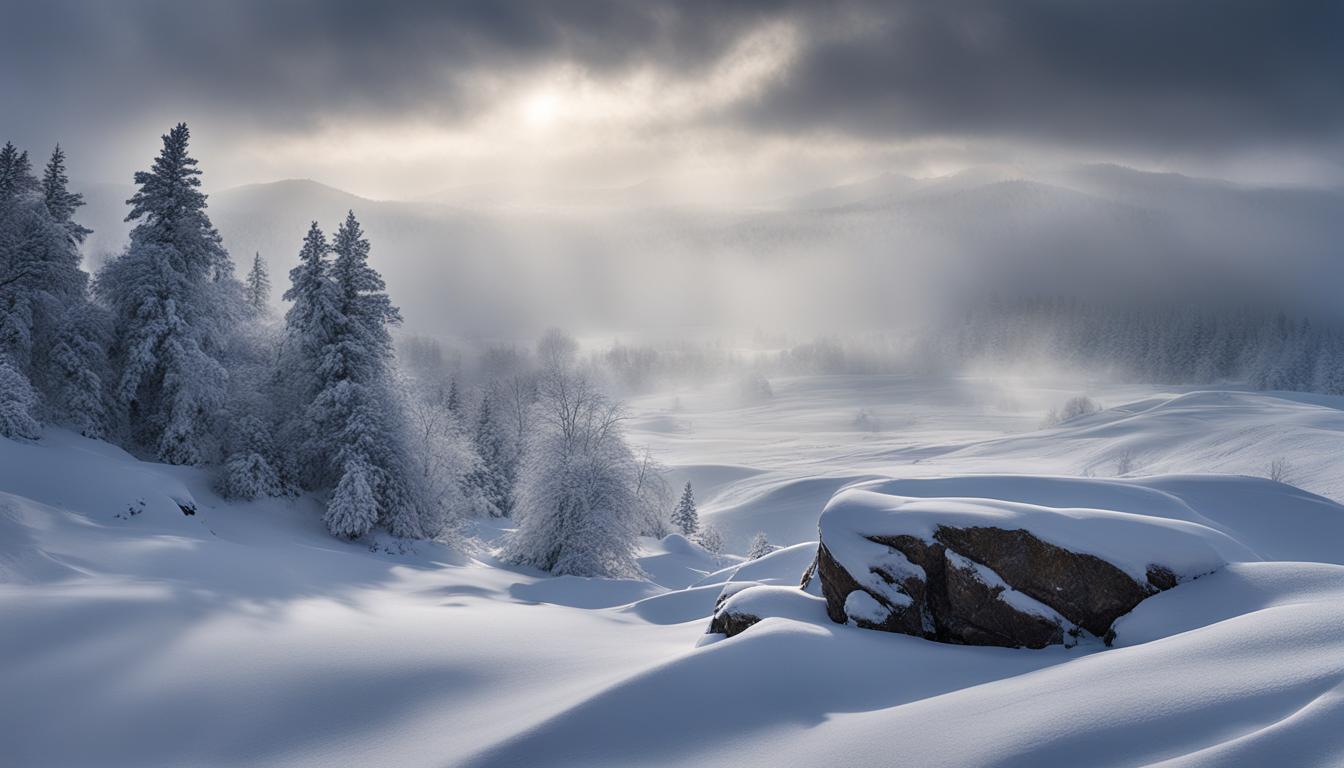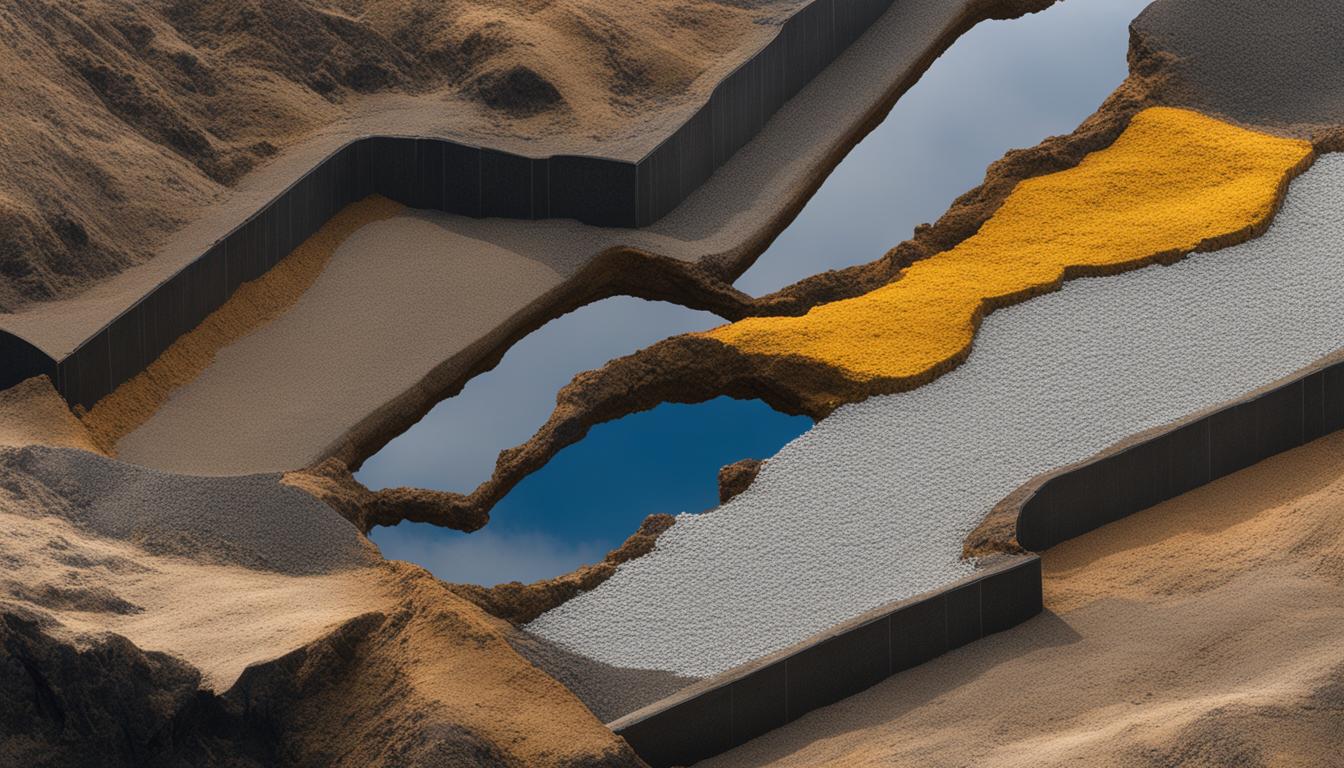A blizzard and a whiteout are both winter weather phenomena, but they have distinct differences. A blizzard is characterized by strong winds blowing at speeds above 35 mph and reduced visibility of less than 1/4 mile for more than 3 hours. On the other hand, a whiteout is a weather condition in which snow-covered landscapes lose their distinct features, making it difficult to navigate. The definition of a whiteout also includes situations where visibility and contours are greatly reduced by sand. The main difference between the two is the wind strength requirement for a blizzard.
Key Takeaways:
- A blizzard is characterized by strong winds and heavy snowfall, while a whiteout refers to reduced visibility and loss of visual references in a snow-covered landscape.
- A blizzard requires wind speeds above 35 mph, while a whiteout can occur with or without strong winds.
- Both blizzards and whiteouts pose hazards to activities such as driving, outdoor sports, and aviation.
- Blizzards are defined by the National Weather Service as large amounts of falling or blowing snow with reduced visibility.
- Whiteouts can occur naturally or be artificially created near airports and helipads due to aircraft operations.
How a Whiteout Occurs
A whiteout can occur in different ways. In blizzard conditions, snow on the ground is blown by strong winds, reducing visibility to near zero. This is often accompanied by heavy snowfall, creating a dangerous combination of reduced visibility and snow accumulation. The strong winds in a blizzard can pick up snow that is already on the ground, further reducing visibility and creating hazardous travel conditions.
In addition to blizzards, a whiteout can also occur during snowfall conditions, where heavily falling snow can obscure objects and create a whiteout effect. This is commonly seen in lake-effect snow or mountain-effect snow, where the volume of snow can be significantly greater than in a typical snowfall or blizzard. The heavy snowfall can quickly accumulate, leading to a loss of visibility and difficulty navigating.
Another factor that can contribute to a whiteout is the diffuse lighting that occurs when overcast clouds combine with a snow-covered ground. The combination of these elements can cause all surface definitions to disappear, resulting in a loss of visual reference points. This can create a disorienting and potentially dangerous situation for individuals navigating through a whiteout.
How a Whiteout Occurs
“A whiteout can occur in different ways. In blizzard conditions, snow on the ground is blown by strong winds, reducing visibility to near zero. This is often accompanied by heavy snowfall, creating a dangerous combination of reduced visibility and snow accumulation.”
Blizzards and heavy snowfall are not the only causes of whiteouts. Diffuse lighting conditions can also contribute to whiteout conditions. When overcast clouds combine with a snow-covered ground, the lack of contrast can make it difficult to differentiate between objects and the surrounding environment. This can lead to a loss of visual reference points and a sense of disorientation, particularly in wide open areas.
In summary, a whiteout can occur through a combination of factors, including blizzard conditions with strong winds and heavy snowfall, as well as diffuse lighting conditions that cause a loss of surface definition. These conditions can make it extremely challenging to navigate and can pose significant hazards in various activities such as driving, outdoor sports, and aviation.
| Causes of Whiteouts | Effects of Whiteouts |
|---|---|
| Blizzard conditions with strong winds | Reduced visibility to near zero |
| Heavy snowfall | Hazardous travel conditions |
| Diffuse lighting conditions | Loss of visual reference points |
Characteristics of a Blizzard
A blizzard is a powerful winter storm characterized by heavy snowfall, low temperatures, and strong winds. While these factors are not necessary for a storm to be classified as a blizzard, they are commonly associated with this extreme weather event. The National Weather Service defines a blizzard as a storm that brings large amounts of falling or blowing snow, along with reduced visibility due to these weather conditions.
The main characteristic of a blizzard is the presence of significant snowfall and wind. The strong winds in a blizzard can pick up snow that is already on the ground, causing it to be blown around and reducing visibility even further. In order for a storm to be classified as a blizzard, it must meet certain criteria set by the National Weather Service, including sustained winds of at least 35 mph and visibility reduced to less than a quarter of a mile for at least three hours.
Blizzards can create hazardous conditions, making travel difficult or even impossible. The combination of heavy snowfall, strong winds, and reduced visibility can lead to accidents on roadways, as well as impacts on air and rail transportation. The extreme cold temperatures associated with blizzards can also pose risks to human health, such as the increased likelihood of hypothermia and frostbite.
Characteristics of a Blizzard:
- Heavy snowfall
- Low temperatures
- Strong winds
- Reduced visibility
| Characteristics | Blizzard | Snowstorm |
|---|---|---|
| Snowfall | Significant and heavy | Varies in intensity |
| Wind Speeds | Sustained speeds of at least 35 mph | Wind speeds can vary |
| Visibility | Reduced to less than 1/4 mile | Can vary depending on the storm |
| Temperature | Typically low | Can vary depending on the storm |
“Blizzards are intense winter storms characterized by heavy snowfall, strong winds, and reduced visibility. They can create dangerous travel conditions and pose risks to human health. It is important to stay informed and take necessary precautions when encountering a blizzard.” – National Weather Service
Hazards of Whiteouts and Blizzards
Both whiteouts and blizzards pose significant hazards to various activities. In a whiteout, individuals, including motorists, mountain climbers, skiers, and pilots, can become disoriented due to the loss of visual references. It can be difficult to distinguish the distance to a snow-covered surface, and even familiar surroundings can become unrecognizable. Similarly, blizzards can lead to dangerous driving conditions, as reduced visibility and strong winds can cause accidents. The cold temperatures associated with blizzards can also increase the risk of hypothermia and frostbite.
“In whiteout conditions, it’s crucial to navigate with caution and rely on alternative means of orientation,” warns meteorologist Jane Smith. “It’s easy to lose track of direction and depth perception, which can result in dangerous situations.”
To illustrate the hazards of whiteouts and blizzards, let’s take a look at the following table:
| Hazards | Whiteouts | Blizzards |
|---|---|---|
| Disorientation | High | Medium |
| Accidents | Medium | High |
| Hypothermia Risk | Low | High |
As shown in the table, whiteouts tend to have a higher risk of disorientation, while blizzards are associated with a higher risk of accidents and hypothermia. It is crucial to exercise caution and take appropriate safety measures when encountering these hazardous weather conditions.
Remember, prevention is key when facing whiteouts and blizzards. Stay informed about weather forecasts, avoid unnecessary travel, and ensure you have the necessary supplies and equipment to stay safe in extreme winter conditions.
Types and Variations of Whiteouts
A whiteout is a weather condition where snow-covered landscapes lose their distinct features, making it difficult to navigate. There are three types of whiteouts, each with its own characteristics and causes.
1. Blizzard Whiteout
A blizzard whiteout occurs during blizzard conditions, where heavy snowfall or windblown snow reduces visibility. This type of whiteout is commonly associated with strong winds blowing at speeds above 35 mph and reduced visibility of less than 1/4 mile for more than 3 hours.
2. Snowfall Whiteout
A snowfall whiteout occurs when heavily falling snow obscures objects and creates a whiteout effect. This can happen during lake-effect snow or mountain-effect snow, where the volume of snow can be much greater than normal snowfalls or blizzards. Diffuse lighting from overcast clouds and snow-covered ground can also contribute to this type of whiteout, causing all surface definitions to disappear.
3. Foggy Whiteout
A foggy whiteout is caused by ground-level thick fog in a snow-covered environment. This type of whiteout occurs when the fog reduces visibility and obscures the landscape, creating a whiteout effect. It is important to exercise caution when encountering this type of whiteout, as it can be disorienting and make navigation challenging.
Whiteouts can also have variations, such as flat-light. Flat-light refers to the diffusion of sunlight due to atmospheric particles and snow on the ground. This can cause a loss of contrast and make it difficult to distinguish features in the landscape, further contributing to a whiteout effect.
| Type of Whiteout | Characteristics | Causes |
|---|---|---|
| Blizzard Whiteout | Reduced visibility due to blowing snow | Strong winds and heavy snowfall |
| Snowfall Whiteout | Obscured objects from heavily falling snow | Lake-effect snow, mountain-effect snow, and diffuse lighting |
| Foggy Whiteout | Thick fog reducing visibility | Ground-level fog in a snow-covered environment |
| Variation: Flat-light | Loss of contrast and difficulty in distinguishing features | Diffusion of sunlight due to atmospheric particles and snow |
Understanding the types and variations of whiteouts is essential for staying safe and navigating challenging winter weather conditions. Whether it’s a blizzard whiteout, a snowfall whiteout, or a foggy whiteout, being aware of the causes and characteristics can help individuals make informed decisions and take necessary precautions.

Artificial Whiteouts and Blizzards
Artificial whiteouts and blizzards can occur as a result of various human activities. Near airports and helipads, the operations of aircraft can stir up snow on the ground, creating whiteout conditions. Helicopter rotor down-wash and airplane jet blast can cause the snow to become airborne, which not only poses hazards to aircraft but also to bystanders. It is essential for airports and helipads to implement measures to mitigate the risks associated with these artificial whiteouts.
In addition to artificial whiteouts, natural blizzards and whiteouts can have severe impacts on transportation. These weather conditions can lead to major multiple-vehicle collisions, making driving extremely dangerous. The combination of reduced visibility and strong winds can cause accidents and pileups on highways and roads. To ensure the safety of motorists during blizzards and whiteouts, it is crucial to exercise caution, follow safety guidelines, and, if possible, avoid travel altogether.
“Artificial whiteouts near airports and helipads can pose significant risks to both aircraft and bystanders.”
Whiteouts and blizzards also have significant effects on aviation. Pilots rely heavily on visual references, and the loss of visibility during whiteout or blizzard conditions can be hazardous. It can become challenging to navigate and maintain situational awareness, particularly during takeoff and landing. It is essential for pilots to receive proper training on how to handle these weather conditions and to follow established protocols to ensure the safety of passengers and crew.
| Comparison of Artificial Whiteouts and Natural Blizzards | Artificial Whiteouts | Natural Blizzards |
|---|---|---|
| Hazard | Potential danger to aircraft and bystanders | Dangerous driving conditions, risk of accidents, and pileups |
| Causes | Aircraft operations near airports and helipads | Natural weather conditions with heavy snowfall and strong winds |
| Precautions | Implement safety measures at airports and helipads | Exercise caution, follow safety guidelines, and avoid unnecessary travel |
Conclusion
In conclusion, the difference between a blizzard and a whiteout lies in their distinct characteristics. A blizzard is defined by strong winds, heavy snowfall, and reduced visibility, while a whiteout refers to a condition where snow-covered landscapes lose their distinct features.
Both blizzards and whiteouts pose hazards to various activities, such as driving, outdoor sports, and aviation. It is crucial to be aware of these differences and take necessary precautions when encountering these weather conditions.
Whether it’s navigating through a blizzard or dealing with a whiteout, it is essential to exercise caution and follow safety guidelines to mitigate the risks associated with these winter weather phenomena.
FAQ
What is the difference between a blizzard and a whiteout?
A blizzard is characterized by strong winds blowing at speeds above 35 mph and reduced visibility of less than 1/4 mile for more than 3 hours. A whiteout refers to a condition where snow-covered landscapes lose their distinct features, making it difficult to navigate.
How does a whiteout occur?
A whiteout can occur in blizzard conditions where snow on the ground is blown by strong winds, reducing visibility to near zero. It can also occur during heavy snowfall when falling snow obscures objects. Diffuse lighting from overcast clouds and snow-covered ground can also cause surface definitions to disappear, resulting in a loss of visual reference points.
What are the characteristics of a blizzard?
A blizzard is typically accompanied by heavy snowfall and low temperatures. However, these factors are not necessary for a storm to be classified as a blizzard. The National Weather Service defines blizzards as large amounts of falling or blowing snow with reduced visibility. The strong winds in a blizzard can pick up snow that is already on the ground, further reducing visibility.
What are the hazards of whiteouts and blizzards?
Both whiteouts and blizzards pose hazards to various activities. In a whiteout, individuals can become disoriented due to the loss of visual references. This can be dangerous for motorists, mountain climbers, skiers, and pilots. Blizzards can lead to dangerous driving conditions, accidents, and increased risk of hypothermia and frostbite due to the cold temperatures.
What are the types and variations of whiteouts?
There are three types of whiteouts. The first is a blizzard whiteout, where heavy snowfall or windblown snow reduces visibility. The second type occurs during snowfall conditions, where the volume of falling snow obscures objects. The third type is a whiteout caused by ground-level thick fog in a snow-covered environment. Variations of whiteouts include flat-light, which is a diffusion of sunlight due to atmospheric particles and snow on the ground.
Can artificial whiteouts and blizzards occur?
Yes, near airports and helipads, whiteout conditions can be artificially created due to aircraft operations. Snow on the ground can be stirred up by helicopter rotor down-wash or airplane jet blast, posing hazards to both aircraft and bystanders. Natural weather conditions can also cause severe impacts on transportation, leading to major multiple-vehicle collisions.
Is there a conclusion to the difference between blizzards and whiteouts?
In conclusion, blizzards and whiteouts are related winter weather phenomena with distinct differences. A blizzard is characterized by strong winds, heavy snowfall, and reduced visibility, while a whiteout refers to a condition where snow-covered landscapes lose their distinct features. Both pose hazards to various activities, and it is important to be aware and take necessary precautions when encountering these weather conditions.
 Skip to main content
Skip to main content


